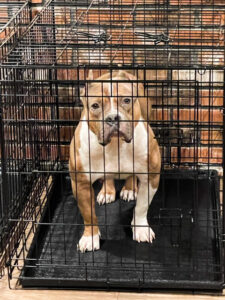Welcoming a new puppy into your home is an exciting and joyful experience. As a responsible pet owner, it’s crucial to establish good habits and routines from the very beginning. One such essential routine is crate training. Crate training provides a safe and comfortable space for your puppy and aids in housebreaking and preventing destructive behavior. In this blog, we’ll explore the pros and cons of crate training, focusing on French Bulldogs and American Bullies, and provide a scale of difficulty for these breeds.
Pros of Crate Training
- A Safe Haven: A crate serves as a personal space for your puppy, where they can retreat when they feel overwhelmed or tired. This can be especially useful when guests are over or during busy household activities.
- Housebreaking: Crate training plays a crucial role in housebreaking your puppy. Since dogs instinctively avoid soiling their sleeping area, a crate helps teach them to hold their bladder until they can be taken outside.
- Prevent Destructive Behavior: A crate helps prevent your puppy from chewing on household items or engaging in other destructive behaviors when you’re not around to supervise. This keeps your belongings safe and protects your puppy from potential harm.
- Travel and Vet Visits: A crate-trained dog is easier to transport, whether it’s a trip to the vet or a family vacation. Crate training makes these experiences less stressful for both you and your pet.

Cons of Crate Training
- Initial Resistance: Some puppies may be resistant to being confined in a crate. This resistance can manifest as barking, whining, or even attempting to escape. Proper crate training techniques and patience will help your puppy adjust to their new environment.
- Overuse: While crates are valuable tools, they should not be relied upon as a permanent solution for containing your puppy. Overuse can lead to feelings of isolation and anxiety in your pet, so balancing crate time with plenty of socialization and interaction is essential.
- Size and Space: Crates can occupy a significant amount of space in your home. It’s essential to choose a large crate for your puppy to stand up, turn around, and lie down comfortably, but not too large, as this can hinder the housebreaking process.

Difficulty Scale for Crate Training French Bulldogs & American Bullies
French Bulldogs: 3/5
French Bulldogs are generally known for their amicable nature, making them relatively easy to train. However, they can also be stubborn sometimes, requiring additional patience and consistency during the crate training process. Providing a comfortable crate, introducing the crate gradually, and using positive reinforcement techniques such as treats, and praise will make crate training a smoother experience for you and your French Bulldog.
American Bullies: 4/5
American Bullies are intelligent and eager to please, but they can also be strong-willed and require consistent training techniques. Their larger size may also present some challenges when finding an appropriately sized crate. Be prepared to invest time and effort in crate training your American Bully, using positive reinforcement and patience to achieve the best results.
Tips for Successful Crate Training:
- Choose the Right Crate: Select a crate that is the appropriate size for your puppy, with enough room for them to stand up, turn around, and lie down comfortably.
- Gradual Introduction: Begin by introducing your puppy to the crate with the door open, allowing them to explore it freely. Place comfortable bedding and some of their favorite toys inside to create a welcoming environment.
- Positive Reinforcement: Give your puppy treats and praise to enter the crate.

In conclusion, crate training is essential to raising a well-adjusted and well-behaved puppy. With patience, consistency, and positive reinforcement, you can effectively crate train your new furry family member, providing them with a safe and comfortable space while ensuring good behavior
and a strong foundation for a happy and healthy life together. While French Bulldogs and American Bullies can be successfully crate trained, they each present unique challenges. French Bulldogs score a 3/5 on the difficulty scale due to their stubbornness, while American Bullies score a 4/5 due to their strong-willed nature and larger size



